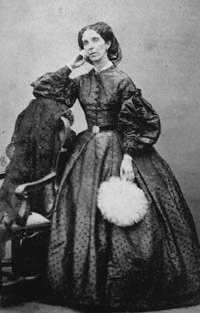Theodosia Trollope
| Theodosia Trollope | |
|---|---|

Theodosia Trollope (from a book in Boston Library)
|
|
| Born | 28 November 1816 Devon |
| Died | 13 April 1865 Florence |
| Nationality | British |
| Genre | poetry, translation, non-fiction |
| Spouse | Thomas Adolphus Trollope |
| Children | Beatrice |
Theodosia Trollope born Theodosia Garrow (1816–1865) was an English poet, translator, and writer known also for her marriage into the Trollope family. She married and bought a villa in Florence, Italy with her husband, Thomas Adolphus Trollope. Her hospitality made her home the centre of British society in the city. Her writings in support of the Italian nationalists are credited with changing public opinions.
Theodosia Garrow was born in 1816 and raised in Torquay, Devon, England. Her parents were Joseph Garrow and the singer Theodosia Abrams Fisher. Her father was part Indian and he is known for making the first translation of La Vita Nuova by Dante Alighieri. Her mother was Jewish. This was the second marriage for her mother, who came to the marriage with two children from her deceased husband, a naval officer.
Garrow had her first poetry published in 1839 and she then contributed articles for a number of publications including Household Words published by Charles Dickens. Her poetry was lauded by Walter Savage Landor and compared to that of Elizabeth Barrett; however, Barrett herself did not feel the comparison was justified. Barrett wrote that Trollope's work was "flowingly & softly written, with no trace of the thing called genius".
Trollope and her family went on a trip to Florence in 1844. Her father published his Dante translation in 1846. Whilst she was a guest of Fanny Trollope, she met and married Fanny's son Thomas Adolphus Trollope (brother of the writer Anthony Trollope).
After their marriage, they had a daughter, Beatrice, who was born in March 1853. The couple made their Italian household into a leading location; it was visited by the visiting British intelligentsia as well as leading Italian figures. "Mrs Trollope" was a celebrated hostess. She lived with her daughter, her husband and his mother at the Villino Trollope on the square that was then called the Piazza Maria Antonio and is now called the Piazza dell'Indipendenza in Florence. Their house was decorated by carved furniture, inlaid walls, majolica ceramics, marble floors and pillars, suits of armour and a 5,000-book library.
...
Wikipedia
